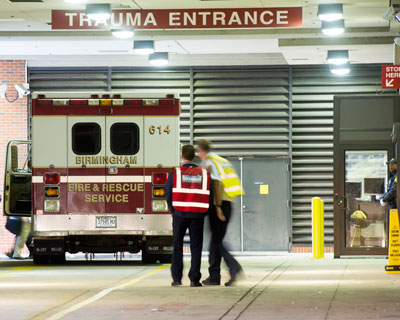
One of the changes was equipping students to adapt to the dynamic environment in community and mental health clinical experiences. The cohort of students was split. Half did their psychiatric nursing clinical with hospitalized patients, and half were in community settings seeing clients with mental health problems or who were homeless.
Then they switched. The results were positive.
“Community and mental health clinical experiences are closely related because both deal with vulnerable populations. Clients with behavioral health issues have similar comorbidities and problems whether hospitalized or receiving treatment in the community. With these changes, students engaged in care across hospital and community environments and realized the impact nursing could have in the community promoting health across these settings,” she said.
And the creativity didn’t stop there. Knowing that nurses and patients often don’t come from the same communities, Phillips and her team of instructors came up with unique learning experiences that would give the
AMNP students an in-depth look at the issues facing different communities — some from a first-person perspective.
One of the modules for the community clinicals focused on vulnerable populations. The students were assigned to use the local public transportation system to experience many of the same difficulties of patients who rely on our inadequate bus system to access health care, obtain their medications and buy groceries.
They were then asked to assess the community based upon the ease of finding healthy foods, what types of stores and restaurants they could find, the condition of real estate, etc.
“This is an excellent learning experience because it enables students to engage directly in the experiences of persons in underserved communities,” Phillips said. “One student, after using public transportation to try to get from their assigned community to a health clinic, and realizing the time and effort it took, cried. They had no idea what people went through just to be able to see a health care provider. Most of these students have never faced that type of hardship. But most importantly the students were able to improve care for persons in these settings.”
Phillips added that the bus ride windshield survey through different communities also was eye-opening.
“Most students reported dollar stores and a lot of fast food restaurants, places to buy alcohol and tobacco, and bars on the windows of occupied buildings and decaying vacant real estate,” she said. “This worked well and was a good learning experience because it gave the students an idea of how difficult it is for vulnerable populations to secure their medications and find healthy foods in their communities. Not to mention dangers they would face in the community trying to get these items.”
The students didn’t just look at communities as a contemporary care setting. They also spent time with first responders who go into these communities of vulnerable populations, studying the impact on this workforce and the challenges inherent in delivering care.
“They were assigned to ride along with Birmingham Fire and Rescue and look at the community from the perspective of a pre-hospital provider working in an environment that is essentially uncontrolled,” Phillips said. “The students also accompanied paramedics into emergency departments to see how both the patients and first responders were treated. It gave them an excellent perspective to see how their actions as a nurse and a leader can impact the workflow and workday of others, as well as the patient experience.”
Phillips said it is important for students to have global health experiences as well, though international travel is impractical.
The School uses the Lineville, Alabama-based SIFAT training facility, which offers a simulated global village demonstrating the issues these villages face to give students a perspective of how the global environment impacts health.
“The exercises in the villages show students how outside forces, like famine, drought and war, can control poverty and health,” she said. “There also is a simulated slum, giving the students a perspective of how desperate people keep their families fed and sheltered, how sex trade workers take women away and how village leaders are not always respectable people, and how all of this impacts health.”
“Teaching strategies that actively engage students in real-life experiences are essential to increase students’ depth of understanding of issues,” said Professor Linda Moneyham, PhD, RN, FAAN, Senior Associate Dean of Academic Affairs. “Such activities serve to challenge students’ preconceived notions of populations and to facilitate the application of concepts and principles they learn in the classroom. These experiments help us to prepare nurses with the competence to care for populations whose culture and life experiences are different than their own. Our faculty are applying similar innovative strategies in our other programs to achieve this level of engagement.”